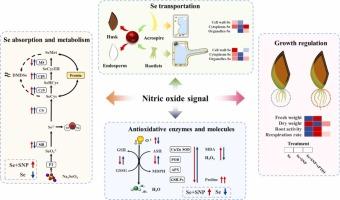一氧化氮减轻大麦中硒的植物毒性:抑制硒的吸收,改变硒的分布,增强抗氧化系统
IF 4.1
2区 生物学
Q2 BIOCHEMISTRY & MOLECULAR BIOLOGY
引用次数: 0
摘要
硒污染可能对富硒环境下的农业可持续性和粮食安全构成重大挑战。研究了一氧化氮(NO)在提高大麦硒耐受性方面的潜力。硒胁迫显著提高了大麦内源NO含量,而外源NO供体硝普钠(SNP)通过下调HvPT基因的表达限制了硒的吸收。此外,NO通过上调HvSIR、HvCS、hvc - γ s和hvc - β l基因的表达来加速硒代谢,从而使大麦有机硒的比例提高到86.6% %。NO通过促进新生组织向活性较低的组织转移来改变硒的分布,并在亚细胞水平上将硒的分布从可溶性部分转移到细胞壁。SNP显著上调抗氧化相关基因(Cu/Zn SOD、APX、GSH- px),提高非酶促抗氧化基因(GSH、AsA)含量。这些保护作用被NO清除剂(cPTIO)所消除,证实了NO的特殊作用。此外,NO通过提高根系活力、呼吸速率和脯氨酸积累来缓解硒诱导的生长抑制。总之,本研究突出了NO在大麦硒代谢和抗氧化防御中的作用,为优化富硒作物提供了新的见解。本文章由计算机程序翻译,如有差异,请以英文原文为准。

Nitric oxide mitigates selenium phytotoxicity in barley: Inhibiting selenium absorption, altering selenium distribution, and strengthening the antioxidant system
Selenium (Se) contamination may pose significant challenges to agricultural sustainability and food security in Se-rich environments. The potential of nitric oxide (NO) in improving Se tolerance in barley was investigated in this study. Selenium stress greatly increased endogenous NO content in barley, while exogenous NO donor (sodium nitroprusside, SNP) limited Se uptake by downregulating the expression of HvPT gene. Additionally, NO accelerated Se metabolism by upregulating the expression of HvSIR, HvCS, HvCγS, and HvCβL genes, thereby raising the proportion of organic Se in barley to 86.6 %. NO altered Se distribution by facilitating the translocation from nascent tissues to less active tissues, and shifted Se distribution from the soluble fraction to the cell wall at the subcellular level. SNP significantly upregulated antioxidant-related genes (Cu/Zn SOD, APX, GSH-Px), and elevated the content of non-enzymatic antioxidants (GSH, AsA). These protective effects were abolished by NO scavenger (cPTIO), confirming the specific role of NO. Additionally, NO alleviated Se-induced growth inhibition by enhancing root vigor, respiration rate, and proline accumulation. Overall, this study highlights the role of NO in modulating Se metabolism and antioxidant defenses in barley and provides novel insights for optimizing Se-enriched crops.
求助全文
通过发布文献求助,成功后即可免费获取论文全文。
去求助
来源期刊

Plant Science
生物-生化与分子生物学
CiteScore
9.10
自引率
1.90%
发文量
322
审稿时长
33 days
期刊介绍:
Plant Science will publish in the minimum of time, research manuscripts as well as commissioned reviews and commentaries recommended by its referees in all areas of experimental plant biology with emphasis in the broad areas of genomics, proteomics, biochemistry (including enzymology), physiology, cell biology, development, genetics, functional plant breeding, systems biology and the interaction of plants with the environment.
Manuscripts for full consideration should be written concisely and essentially as a final report. The main criterion for publication is that the manuscript must contain original and significant insights that lead to a better understanding of fundamental plant biology. Papers centering on plant cell culture should be of interest to a wide audience and methods employed result in a substantial improvement over existing established techniques and approaches. Methods papers are welcome only when the technique(s) described is novel or provides a major advancement of established protocols.
 求助内容:
求助内容: 应助结果提醒方式:
应助结果提醒方式:


